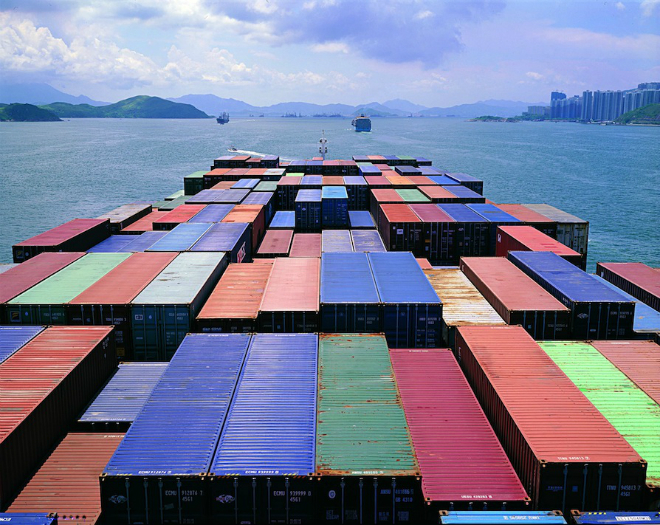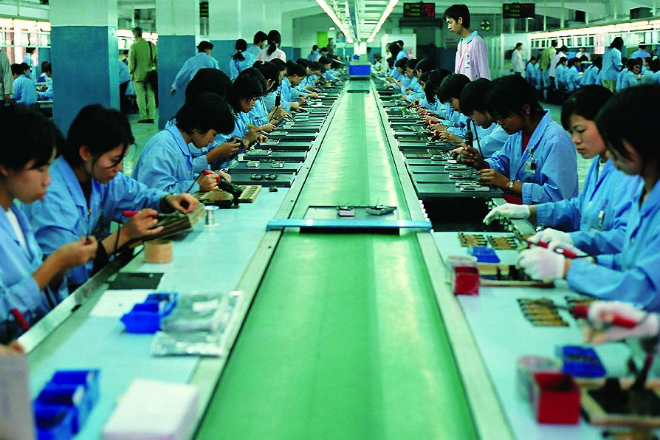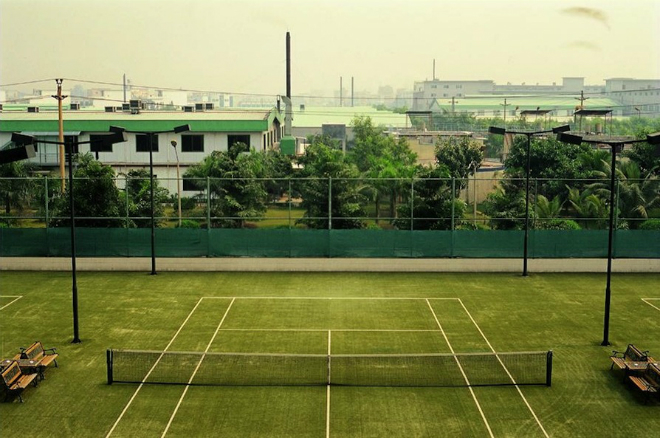Robin Peckham explores the oeuvre of MAP Office and their place in the strange art ecology of Hong Kong and greater China.
“Back Home with Baudelaire” is an extraordinarily poetic title, all the more so when one considers the rather prosaic content of the documentary video work that it names: two artists record the short (but rarely experienced) journey on a container ship from the port of Shenzhen to the neighboring harbor of Hong Kong. Somehow, it is consistently this unexpected moment of surreal romanticism that captivates the mind, obscuring the far more radical tendencies of this title and the processes of cultural negotiation behind it. At face value, what matters is not so much that this is a French ship traversing Chinese territorial waters so much as the fact that these are French artists living in Hong Kong and returning “home,” aligning themselves more, through the work of their ambiguous little title, with this particular place than with their lettered compatriot.
MAP Office, a longstanding label for the collaborative artistic practice of Valerie Portefaix and Laurent Gutierrez, was founded in Hong Kong in 1996. The project “Back Home with Baudelaire” was executed in 2005, after upwards of a year of correspondence with the shipping company that ultimately made it possible. It was exhibited that same year in the Guangzhou Triennial, curated by Hou Hanru and for which MAP Office also contributed an overall exhibition design. In 2013 a still image extracted from the work won the Sovereign Asian Art Prize, resulting in the most sustained period of media focus yet for the duo, due in part to the ascendency of Hong Kong on the international art calendar this year. Such is the politics of home: it has taken the better part of a decade for this work to be shown at home in Hong Kong, and almost two decades for their adopted home to finally recognize the critical work in which they have engaged almost since the moment of their arrival on these shores.

“Back Home with Baudelaire,” video transferred to DVD Color with no sound, 10 min (video still), 2005.
It is no secret that artists of non-Asian descent working across Asia have often felt a lack of curatorial interest over the past quarter century, even as artists of Asian descent have struggled for institutional attention in Europe and North America. So it was that the corporate moniker — or mask — “MAP Office” came to act as a convenient stand-in for ethnically suggestive personal names, not to mention initiating 15 years of misunderstandings as to whether Portefaix and Gutierrez were practicing as artists or architects. But if tactics like these managed to evade in some small way the insidious identity politics that otherwise hampered the reception of their radical experiments in the urbanism of the Pearl River Delta, MAP still found themselves generally inhabiting the interstices between various identity-based communities: invited to Chinese exhibitions for an international perspective, international exhibitions for a Hong Kong perspective, and Hong Kong exhibitions for a perspective on China, their work has been difficult to place — to say the least.
During their first decade in Hong Kong MAP Office produced three books that have proven invaluable in shaping intellectual discourse around the urbanism of the Cantonese megacity: Mapping HK (2000), HK LAB 1 (2002), and HK LAB 2 (2005). They also proposed a conceptual plan for the West Kowloon Cultural District, involving repetitive forms reminiscent of shipping containers that made it impossible to define where the harbor ended and reclaimed territory began; in the same vein, they advocated the installation of massive rubber atolls filled with clean water for swimming just offshore (see Hong Kong Gateway [1997] and Atoll Membrane [1999]). Moving into the Pearl River Delta proper, MAP made videos about cross-border factories and the social spaces surrounding them, shot portraits of their blond children with groups of anonymous extended families in the Window of the World theme park, catalogued the many and varied instances of creative land use in spaces under major highways, and devised a visual language for the just-in-time urbanism then making its mark on the Lingnan landscape (see “ALCO Story” [2003], “Sun Hing Story” [2003], “City of Production” [2004], “My Chinese Family” [2004], “Underneath” [2004], “Pixel” [2006-2008], and “Extended Territory” [2007]). These projects were all well-exhibited, notably at Para/Site during its Tobias Berger era, the Goethe-Institut in Hong Kong, and the Venice Biennale pavilion curated by Norman Ford. Never, however, did they truly enter the canon of contemporary Chinese art as defined, in many cases, by the luminaries with which they have collaborated: Cao Fei, Hu Fang, Hou Hanru, Ai Weiwei, Johnson Chang — the list goes on.
The position of contemporary art in South China vis-à-vis the identity politics of Chinese contemporary art throughout the 1990s and into the 2000s is a complex one, and one that cannot be served in full here. Suffice it to say that one of the many reasons why artists emerging from Guangdong — as diverse as Chen Shaoxiong, Cao Fei, Jiang Zhi, and Zheng Guogu — made such an immediate and lasting impression on the northern centers of gravity at that time was their grasp of a distinct visual language, namely that of global youth culture originating in Europe and Japan as filtered through Hong Kong television, magazines, and consumerism. It should be evident that, while MAP Office indubitably contributed to this infusion, their status as immigrants deadened the blow in certain ways: Chinese audiences expected something alien from them, so the shock of the new failed to impress. Their critical take on Hong Kong architecture, so important to Chinese cultural discourse as it has developed today, paled in comparison to the revelations of video installation coming out of Guangzhou in the mid-1990s, partially because Hong Kong was still thought of as an unreachable colonial island while Guangzhou had largely been considered a southern analogue to Tianjin.
Of course, there is also the difficult fact that, while artists like Chen Shaoxiong and Cao Fei made themselves historically indispensable by bringing an innovative visual language to their explorations of the changing Chinese city, MAP Office has never cared much for formal considerations per se. Many of their projects, particularly earlier pieces based in architectural research, appear downright disagreeable in their visual approach (see, for instance, “No Crisis? Crisis…” [1997]). This has changed somewhat over time, but still they are careful to always privilege discursive content — often derived from post-1968 French theory — over visual form, even to the detriment of the circulation of their video and spatial work. It is a valiant fight, if an unpopular one: elsewhere in the Hong Kong art world, discourse is the exclusive province of the shoe-shining picture salesman, who always makes sure to drop a few references to philosophy and criticality in his silver-tongued pitches.
In a way, then, it is a beautiful irony that the piece that has finally won over the hearts of the Hong Kong public (even if it appears only as a still photograph rather than a video installation) is one of the few MAP Office efforts to truly throw its weight behind formal qualities in their pure simplicity. “Back Home with Baudelaire” is a remarkably well-composed visual object, and indeed serves as the tip of a deadly discursive iceberg; if this is what it takes to finally bring MAP Office home — and, perhaps, into the regional canon — then a pretty picture is a small price to pay.




